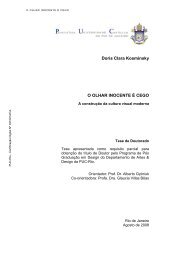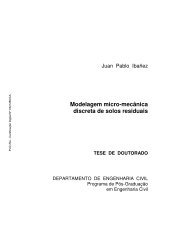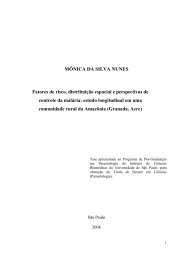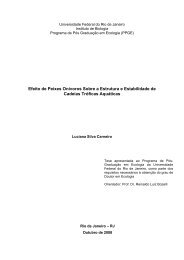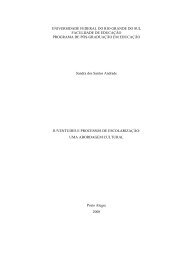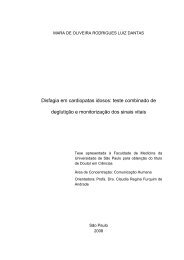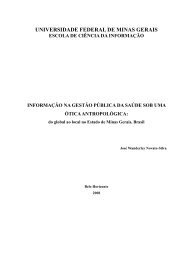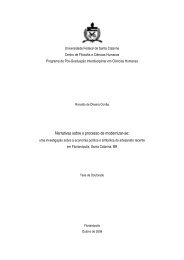You also want an ePaper? Increase the reach of your titles
YUMPU automatically turns print PDFs into web optimized ePapers that Google loves.
Promiscuous <strong>gene</strong> expression in murine FTOCcDNA microarray methodA set of six microarrays were used containing a total of9216 cDNA sequences (1536 sequences each) in the formof polymerase chain reaction (PCR) products, spotted induplicate on 25 · 75 cm Hybond N + nylon membranes(GE Healthcare, Amersham, UK). The arrays were preparedin our laboratory using a Generation III ArraySpotter (Amersham Biosciences-Molecular Dynamics, Sunnyvale,CA, USA).Mouse thymus expressed sequence tag cDNA cloneswere obtained from the Soares thymus 2NbMT normalizedlibrary, prepared from the thymus of a C57BL/6J4-week-old male mouse, and available from the IMAGEConsortium (http://image.llnl.gov/image/html/iresources.shtml) and from the RZPD Deutsches Resourcenzentrumfür Genomforschung GmbH (http://www.rzpd.de).The cDNA inserts were homo<strong>gene</strong>ous in size (near1 kb), cloned in three vectors (pT7T3D, pBluescriptand Lafmid) and were amplified in 384- or 96-well platesusing vector-PCR amplification with the followingprimers, which recognize the three vectors: LBP 1SGTGGAATTGTGAGCGGATACC forward and LBP 1ASGCAAGGCGATTAAGTTGG reverse. This set of cDNAsincluded sequences of some known autoantigens, such assmall nuclear ribonucleoprotein SMD1, lupus Ku proteinp70, p80 and p86 and PM-SCL; the full list of cDNAsequences used to prepare the microarrays can be retrieve<strong>do</strong>nline at http://rge.fmrp.usp.br/passos/mtb_library.The membranes were first hybridized with LBP 1AS[c- 33 P]dCTP-labelled oligonucleotide (vector hybridization).Quantification of the signals obtained allowed for theestimation of the amount of cDNA insert fixed in each spot.After stripping, the membranes were used for hybridizationwith cDNA complex probes (sample hybridization). Thecharacterization of each cDNA sequence was updated usingthe ELOGE Ò (Ipsogen, Marseille, France, http://www.ipsogen.fr) software, which runs on our local server and links eachclone ID with the genome data banks (http://genomewww5.stanford.edu/cgi-bin/source/sourceSearch),providinginformation such as DNA and protein sequences, biologicaland molecular functions and chromosomal location.Complex cDNA probe preparation and hybridizationIn this study, we refer to the radioactive cDNA originatedfrom the thymus RNA samples (FTOCs) as complexprobe and to the PCR product originated from the clonesand deposited on nylon microarrays as target.The 33 P-labelled cDNA complex probes were preparedby reverse transcription of 10 lg thymus total RNA usingoligo-dT(12-18) as a primer; 100 ll33 P–cDNA complexprobe containing 30–50 million counts per minutewas hybridized with nylon microarrays as previouslydescribed. 20–22cDNA microarray image acquisitionImaging plates and a phosphor imager apparatus (PackardPhosphor Imager, model Cyclone, Packard Instruments,Downers Grove, IL, USA) were used to capture thehybridization signals and the BZScan software 23 was usedto quantify the signals with local background subtraction,whose spots were matched with a template grid. The ratiobetween vector probe hybridization values and complexprobe hybridization values for each spot was used as a referencenormalization value. Total intensity normalizationwas also employed, using the median expression value. 24Significance analysis of microarray dataThe <strong>gene</strong> expression data analysed here were obtainedfrom six independent determinations for each day of fetaldevelopment in FTOC. The SAM method 25 (SignificanceAnalysis of Microarrays, available at http://www.stat.stanford.edu/tibs/SAM/index.html) was used to analysesignificant variations in <strong>gene</strong> expression. This methodis based on t-test statistics, specially modified for highthroughput analysis. The significant variations in the <strong>gene</strong>expression of developing thymus in FTOCs were comparedusing the 15-day p.c. as reference (15 versus 16, 15versus 17 and 15 versus 20 days of development). In thisstudy, only those <strong>gene</strong>s presenting a two-fold changeof expression (either repressed or induced) and a <strong>gene</strong>error chance (q-value) equal to 001 (see SupplementaryTable S1) were considered.Determination of PGE in the thymusPGE was identified on the basis of data from microarrayanalysis of the different mouse organs using combinedinformation from the public database GNF Gene ExpressionAtlas 26 (http://symatlas.gnf.org/SymAtlas). This databank shows <strong>gene</strong> expression in more than 60 mouse tissues/organs,as assessed by <strong>gene</strong> array analysis using Affymetricsmicroarrays. Data information includes GenBankaccession, chromosomal location and the molecular/biologicalfunction of each <strong>gene</strong> analysed (Table S1).In this study, only the promiscuous <strong>gene</strong>s of which theexpression was detected in different organs or tissues,besides the thymus, and of which the expression levels weregreater than median in relation to all other organs whichappear in the GNF Atlas were considered. The modulationof transcription levels (repression or induction) of these<strong>gene</strong>s was evaluated during FTOC development.Semi-quantitative reverse transcription-PCR(SQ RT-PCR)The zinc finger protein 369 <strong>gene</strong> (ZNF 369; accNM_178364, clone ID 573600) that was found to beÓ 2006 Blackwell Publishing Ltd, Immunology, 119, 369–375 371



